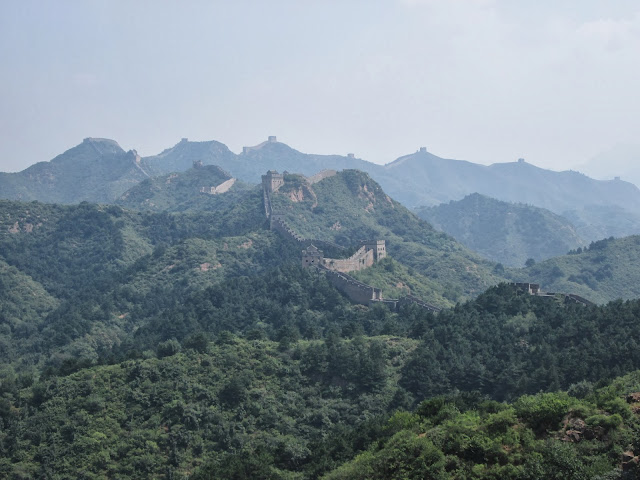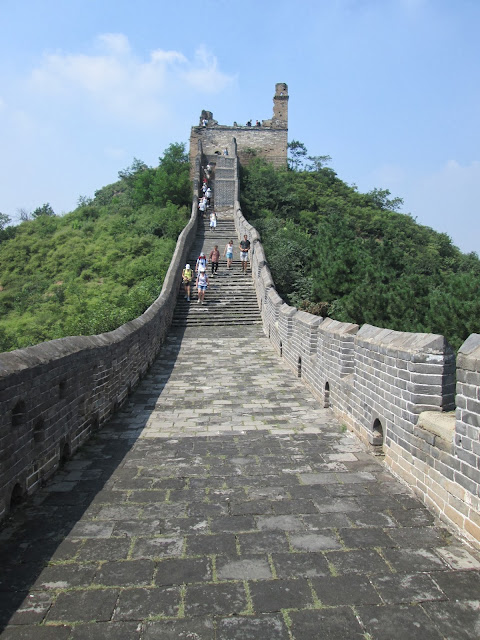Saturday, November 30, 2013
The Great Wall
On my second to last day in China, I reserved a spot on a guided tour of a section of the Great Wall, which is a couple hours north of Beijing by bus. At this point on the trip, it was a real pleasure to leave the logistics to someone else and simply take in the sights. And, with the exception of the guide, everyone on this trip was European or American, so the trip was a sociable experience.
I chose one of the longer tours, which involved walking a few miles along the Wall itself. In retrospect, this was an excellent idea, but it did make for a few nervous moments in the morning as I waited for the staff in the adjoining restaurant to finish making me a sandwich. I just made the bus (a preview of another close call two days later, when I was literally the last person to check in to my flight home). In any case, the walk was hot and very hilly, as the Wall snakes along atop of a mountain ridge. Luckily, I had enough to eat, and had I been hungry, many guard towers had their own vendor selling a range of candies and sodas.
The fascinating thing to me about the wall isn't so much its incredible length but the fact that it was built so high up. As you can see from these photos, the views, though limited by the humidity of the day and general smogginess, are remarkable. The scale of the construction effort drives home two realities about China that endured through most of its dynastic history. First, the Chinese were really scared about incursions from the north. The steppe-dwellers were difficult to defeat as long as they remained on their horses. It's hard to imagine how the Mongols, resourceful and unrelenting as they were, could have scaled these heights with their horses, but a string of emperors and their advisors thought the risk justified all the effort and expense. Second, eastern China never lacked for labor, even 2500-2000 years ago. Apparently, much of the building was carried out by prisoners.
Walking along the Wall was challenging work because the slope of the wall mirrored the underlying steepness of the mountain. Every variety of leg muscle got a good workout, as we covered a full range of ascending and descending angles. The last picture in this series shows the most challenging section, which caused several in our group to gulp pretty hard. Climbing some of these sections with chain mail could not have been fun.
The Chinese have entirely restored some parts of the Wall, while other sections, especially the guard towers, are slowly crumbling. I suspect that the pace of rebuilding is picking up but hope that they don't restore the Wall entirely. Tourists are now allowed to wander around more or less as they choose. At the tower where my group peeled off to return to our bus, I met a pair of young Frenchmen, who continued on along the Wall on their own.
A number of people have asked me about air pollution in Beijing. I must admit that while the smog was bad, especially as we drove out through Beijing, it was not nearly as severe as the worst reports (in Hanjin in early November, most recently, for example). The problem gets worse in the winter when people begin to burn coal for heat.
Now for some more ruminating, as I'm in the midst of several weeks covering East Asia with my sophomores. There's not much question that the Chinese state is authoritative and, when threatened, brutal. In China, the ends justify the means. Just look at the rates of execution, for example: China leads the rest of the world by leaps and bounds. But I encourage western readers to consume our own media reports about China (and, for that matter, Russia) with skepticism. Regarding air pollution, for example, journalists conveniently forget the terrible side effects of American industrialization or existing issues with smog. In Austin, I remember how on certain hot summer days, the populace was warned simply not to go outside because the air quality was so bad. Or, take the current brouhaha over China's efforts expand its territory and influence in East Asia. I don't advocate that the US or China's neighbors acquiesce to its bullying. Yet I am astonished that so many journalists can report on these events without mentioning the Monroe Doctrine; in many respects, America's rise is the model that guides China's leaders.
This will be my last blog entry about the Trans-Siberian trip. I am sad to cease posting about it though, admittedly, the pace of entries has slowed dramatically since school picked up. As fall gives way to winter, these summer travels seem more distant. Happily, another summer vacation beckons.
I also want to point out that I marked my hundredth entry on Gulliver's Nest during this journey. The frequency of my writing has varied during the seven years since the site's founding, generally picking up during summers, for obvious reasons. The middle of last decade saw countless blogs launched, and in the years since, many have become more professional, while others faded as the novelty of online writing wore off. I hope I can continue to navigate an intermediate course because this blog is as much about recording the feelings and discoveries associated with travel for myself as it is to entertain readers. Anyway, thank you to those of you who continue to faithfully read my observations.
Subscribe to:
Post Comments (Atom)










No comments:
Post a Comment